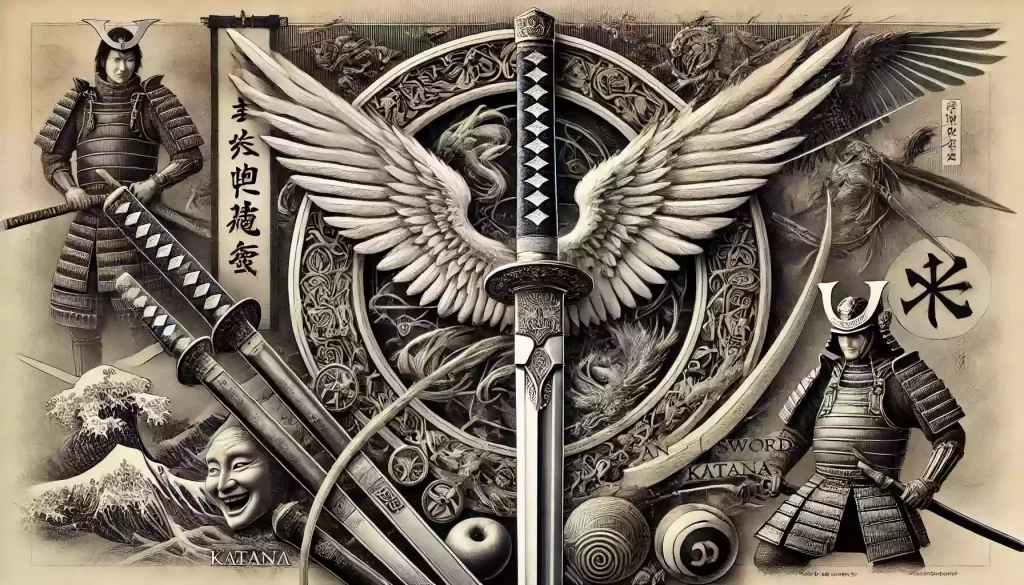The katana, an iconic symbol of the samurai spirit, has been celebrated as a pinnacle of Japanese craftsmanship for centuries. Among these legendary swords, the Angel Sword Katana is distinguished by its fusion of traditional techniques and contemporary innovations. This blog delves into the history, craftsmanship, and significance of the Angel Sword Katana, explaining why it stands out as a marvel in the world of bladed weapons.

Ⅰ.History of the Angel Sword Katana
1.Origins and evolution:
The Angel Sword Katana is a modern creation compared to traditional Japanese swords. It was designed by master swordsmith Daniel Watson, who aimed to combine ancient Japanese sword-making techniques with modern materials and technology. This blend creates a katana that respects traditional aesthetics while enhancing performance and durability.
2.Influence of traditional Japanese sword-making:
While the Angel Sword Katana incorporates modern elements, its foundation is deeply rooted in the rich history of Japanese sword-making. The techniques used draw heavily from methods developed during the Heian and Kamakura periods, ensuring that each Angel Sword Katana maintains the essence of a true Japanese katana.
Ⅱ.Craftsmanship of the Angel Sword Katana
1.Selection of materials:
A key feature of the Angel Sword Katana is the use of high-quality materials. Unlike traditional katanas forged primarily from tamahagane steel, the Angel Sword Katana uses advanced alloys that offer superior strength and flexibility. These modern materials enhance the sword’s cutting ability and resilience.
2.Forging process:
Heating and Folding
The forging process begins with heating the chosen steel to a high temperature. The steel is then repeatedly folded and hammered to eliminate impurities and create a uniform structure. This traditional Japanese method ensures that the blade possesses the distinctive grain pattern known as hada.
Shaping and Differential Hardening
After achieving the desired structure, the blade is shaped into its iconic curved form. A clay mixture is applied, with a thicker layer along the spine and a thinner layer along the edge. This coating controls the cooling rate during quenching, resulting in a hard edge and a softer spine. This technique, known as differential hardening, gives the blade its exceptional cutting edge and flexibility.
3.Polishing and sharpening:
The polishing and sharpening process of the Angel Sword Katana is both an art and a science. Using a series of fine whetstones, the blade is meticulously polished to reveal its sharp edge and beautiful grain patterns. This process, which can take several days, ensures that the katana performs exceptionally and looks stunning.
4.Fittings and assembly:
The final stage involves fitting the blade with a hilt (tsuka), guard (tsuba), and scabbard (saya). These components, often crafted from high-quality materials, are intricately designed to complement the blade. The hilt is typically wrapped in ray skin and silk, providing a secure and comfortable grip, while the tsuba protects the hand and balances the sword.

Ⅲ.Significance of the Angel Sword Katana
1.Superior performance:
The combination of traditional craftsmanship and modern materials results in a katana that excels in performance. The Angel Sword Katana is known for its sharpness, durability, and perfect balance, making it both a collectible piece and a functional weapon for martial arts and cutting demonstrations.
2.Aesthetic appeal:
Beyond its functionality, the Angel Sword Katana is a work of art. The intricate details of the blade, the beautiful hada pattern, and the elegant fittings make it a visually stunning piece. Collectors and enthusiasts admire the sword for its cutting prowess and aesthetic beauty.
3.Cultural and historical value:
While the Angel Sword Katana is a modern creation, it embodies the cultural and historical essence of traditional Japanese katanas. It represents a bridge between the past and the present, honoring the legacy of samurai warriors while incorporating contemporary advancements. Owning an Angel Sword Katana is a way to connect with the rich history of Japanese swordsmanship.
Ⅳ.Modern-Day Relevance
1.Collectibility:
The Angel Sword Katana has gained significant popularity among collectors. Its unique blend of tradition and innovation makes it a sought-after piece in the world of sword collecting. Each katana is handcrafted, ensuring that no two swords are exactly alike, adding to their exclusivity and value.
2.Practical use:
In addition to being a collectible, the Angel Sword Katana is highly valued by martial artists. Its superior performance characteristics make it an excellent choice for practitioners of traditional Japanese martial arts such as Kendo, Iaido, and Kenjutsu. The sword’s balance, sharpness, and resilience are highly appreciated in cutting exercises and demonstrations.
3.Symbolic significance:
The Angel Sword Katana is more than just a weapon or a piece of art; it is a symbol of dedication, skill, and the pursuit of perfection. It represents the fusion of old and new, showcasing how traditional craftsmanship can evolve and thrive in the modern world. For many, it is a testament to the enduring legacy of the samurai spirit.

Final Thoughts
The Angel Sword Katana exemplifies how tradition and innovation can come together to create something extraordinary. From its meticulously crafted blade to its elegant fittings, every aspect of the katana reflects a deep respect for the art of sword-making. Whether admired as a work of art, valued as a functional weapon, or cherished as a symbol of cultural heritage, the Angel Sword Katana continues to captivate and inspire. It is a testament to the timeless appeal and enduring legacy of the Japanese katana, a true masterpiece of both past and present.